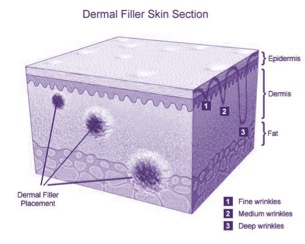Cosmetic Injecting
Part 2 – Dermal Fillers
Dermal fillers background information
Dermal fillers are made of various kinds of natural and man-made or synthetic materials that have been developed over the years for injection into the skin.
This is not a new treatment. As early as the 1890s, doctors could take fat from patients’ arms and inject it into their faces. In fact, fat is still a popular substance used by some practitioners today who can move fatty tissue from an area of the body where it is not required and inject it somewhere else. In the mid 1900s, doctors were using paraffin and then silicone as filler in the skin, with some reported problems regarding safety that prevented them being used widely.
In the U.S.A. in the 1980s, scientists discovered a type of collagen which occurs naturally in the skin that proved to be safe. At this point, the use of fat as a filler material was overtaken by this new collagen.
In the last 10 years hyaluronic acid based dermal filler such as Hylaform®, Restylane® & Juvéderm® have become the preferred ingredient for dermal fillers. It has been used widely in general medicine to help eye surgeons perform cataract operations, and for injection into arthritic joints to aid movement. It is estimated that 30 million patients around the world have been treated with some form of hyaluronic acid.
Hyaluronic acid is a natural linear polysaccharide found in the connective tissues and joint synovial fluid. This makes them extremely safe to use with extremely low potential for allergic reactions.
What are dermal fillers and how do they work?
As the skin ages, it gradually loses some of its collagen and fat. These are the materials that prevent the skin from becoming saggy. Thus, as we age, our skin can become thinner, more wrinkled and lined.
Dermal fillers help to restore our skin to its former youthful appearance. Material is injected into the skin in areas where it needs to be plumped up again and made to look firmer.
Fillers come in different thicknesses, and in general, the thicker the product, the deeper it is injected into the dermis (middle layer of the skin – see diagram below) to help plump out fine to deep lines and wrinkles.

What skin problems can dermal fillers treat?
Collagen treatment has been widely used to increase the size and volume of lips in women for a number of years, and this is still the most popular use for most dermal fillers.
However, these products are also very effective in both men and women in helping to fill out lines around the lips, the lines from the nose to the corners of the mouth (nasolabial lines), smile lines on the cheeks, as well as crow’s feet and forehead wrinkles.
Thicker fillers can also be used to add volume to sunken cheeks and weak chins, reshape the tip of the nose, as well as filling out deeper acne or other scars. In addition, fillers can be used to help reduce the appearance of veins and bones in aged hands with thin skin.
Usually, if you need to have fillers in the upper part of your face for movement lines associated with expression i.e., crow’s feet, forehead and general wrinkle lines, it is usually recommended that the fillers are used alongside injections of botulinum toxin (or Botox®).




Dr Stephen Suster at Vision Dental Menai is an accredited Cosmetic Injection provider.
Call (02) 9543 4222 for a no obligation Cosmetic Injection appraisal.
